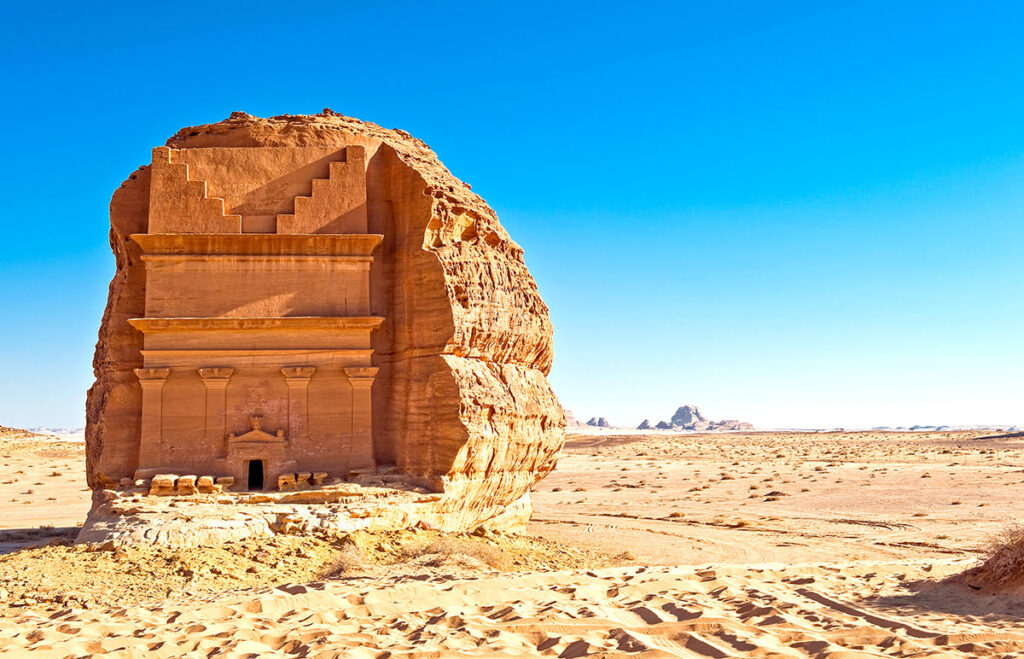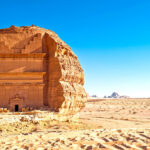Saudi Arabia is a country with a long and rich history spanning thousands of years. While much of the world associates Saudi Arabia with oil wealth and Islam, the country is also home to many intriguing ancient wonders and historic sites that provide a window into its storied past. From prehistoric rock art to towering tombs, Saudi Arabia’s ancient ruins and heritage sites showcase the ingenuity, culture, and achievements of civilizations that once thrived in this harsh yet captivating desert landscape.
In this blog post, we will explore some of the most magnificent and important ancient wonders and historic places found across Saudi Arabia. Understanding and appreciating these sites not only gives insight into the country’s origins but also shows that there is much more to see and experience in Saudi Arabia besides endless sand dunes.
Mada’in Saleh
Located in the Al-Ula valley in northwestern Saudi Arabia, Mada’in Saleh is Saudi Arabia’s largest and most important archaeological site. This Nabataean city served as the southern capital and power base of the Nabataean Kingdom which held sway over northern Arabia and the lucrative incense trade routes two thousand years ago. Mada’in Saleh’s splendidly preserved monumental rock-cut tombs date back to the 1st century CE when the Nabataean Kingdom was at its peak in terms of wealth and influence.
Carved directly into sandstone outcrops with intricate Hellenistic architectural facades, there are over 100 elaborately decorated tombs scattered amidst Mada’in Saleh’s desolate yet hauntingly beautiful desert landscape. The site has often been described as Arabia’s Petra due to its similarities with Jordan’s famous ancient Nabataean city which was the northern capital of the Nabataean Kingdom. Mada’in Saleh was designated a UNESCO World Heritage Site in 2008 both for its immense archaeological importance as well as its visually stunning fusion of Hellenistic, Roman, Nabataean, and Arabic architectural styles set amidst a desert backdrop.
Al-Ula Old Town
Adjacent to the ruins of Mada’in Saleh is the equally historic mudbrick old town of Al-Ula. Once an important oasis settlement on the incense and Hajj pilgrimage trade routes, the old town flourished from the 6th century BCE onwards and is today one of Saudi Arabia’s best preserved historic urban areas. The walled old town is a labyrinth of narrow winding alleys dotted with small plazas that are flanked by traditional Arabian homes, markets, mosques, and defensive watchtowers constructed from mudbrick.
Of particular note is the 12th century CE Al-Ula Castle which looms high above the old town. This crumbling castle with walls 3 meters thick was once the headquarters of the local governor and its strategic location allowed it to defend the old town below as well as control trade caravans entering Al-Ula oasis. In addition to its distinctive Arabian architecture, the old town area also contains ancient rock inscriptions, carvings and archaeological sites such as Qasr Al-Farid – a soaring four-story tomb carved directly into a sandstone cliff. The mudbrick urban fabric of Al-Ula old town along with its ancient rock-cut tombs led to it being designated as a UNESCO World Heritage property.
Hegra/Mada’in Salih
Located near the town of Al-Ula in northwestern Saudi Arabia, Hegra or Mada’in Salih as it is also known was once the second largest city of the Nabataean Kingdom. Built out of the desert itself, Hegra contains a series of monumental rock-cut tombs carved into sandstone outcrops which date back to the 1st century BCE. Numbering over 100 tombs, many of these funerary monuments feature elaborate decorative facades imitating the architecture of temples and Roman-style villas which points to the cosmopolitan nature of the Nabataean civilization.
The desert rock setting, expert masonry and classical stylistic features seen in Hegra’s collection of tombs showcases both the engineering and aesthetic prowess of the Nabataeans who managed to create enduring monuments in such a harsh desert landscape. In addition to its splendid tombs, Hegra also harbors the remnants of vital trade routes, dams, reservoirs and agricultural systems that sustained life in this desert city. Recognizing Hegra’s immense archaeological significance, UNESCO designated it a World Heritage Site in 2008. Hegra offers profound insight into the now vanished Nabataean realm that held lucrative trade monopolies across northern Arabia and the Negev desert two millennia ago.
Jabal Ikmah
The Hijaz mountain range located in western Saudi Arabia is home to Jabal Ikmah, an area which contains over 350 individual rock art panels chronicling the lives of prehistoric inhabitants of this region. Dating as far back as 6000 BCE, these rock art panels carved into the surfaces of sandstone boulders depict vivid scenes of ancient communities engaging in hunting, herding livestock, performing dances and participating in religious rituals. Prominent motifs seen in this unique collection of rock art include oryx, ostriches, camels, giraffes and even lions which populated this region in ancient times when the climate was wetter and greener.
In addition to its wealth of rock art, Jabal Ikmah was also once an important mining region and the rock art illustrates prehistoric peoples extracting metals from these mountains. Jabal Ikmah’s hundreds of petroglyphs and inscriptions make it one of the most extensive rock art sites on the Arabian Peninsula. Since rock art serves as a visual record into preliterate societies, Jabal Ikmah provides an invaluable glimpse into the material culture and symbolic beliefs of ancient tribal communities who inhabited this desert region up to eight thousand years ago!
Tayma
Located in the northern region of Saudi Arabia called Tabuk, Tayma is an exceptionally well-preserved oasis city which contains archaeological evidence of continual settlement spanning over five millennia. Due to its strategic location along the incense trade route which linked southern Arabia with Mesopotamia, Tayma grew to become an economically prosperous city-state mentioned in Assyrian, Babylonian and Biblical sources as early as the 8th century BCE.
The walled city of Tayma boasts a wealth of historic architecture including a sizable temple dedicated to the god Salm dating back to the 2nd century CE. Intriguing rock-cut inscriptions discovered in the nearby Jabal Abu Al-Hassan feature over 40 large dedicatory texts carved into the mountainside which mention various Nabataean gods and date as far back as the 4th century BCE. The longest ancient Arabic text ever discovered was also unearthed on the outskirts of Tayma. Known as the Taymanitic inscription, this text consists of about 40 lines that discuss the rule and legal code of a 6th century CE king named Taym al-Lat. Both an economic hub and center of religion for centuries, Tayma’s oasis city with its mixture of Nabataean, Aramaic and Arabic inscriptions make it an archaeological gem.
Qaryat Al-Fau
Nestled amidst desert hills in northern Saudi Arabia lies the ruins of Qaryat Al-Fau, one of the best preserved archaeological sites in the country. Qaryat Al-Fau began as a prehistoric settlement which eventually grew to become a prosperous caravan city at the crossroads of vital trade routes. The city reached its peak around the 1st century CE when it was the capital of the Kindah kingdom controlling northern Arabia. Qaryat Al-Fau was enclosed by robust mudbrick walls and contained a royal quarter with palaces and elite residences built around a monumental temple dedicated to the god Athirat who was worshipped across pre-Islamic Arabia.
The city also had extensive irrigation systems allowing urban farming and palm groves to thrive despite its desert location. After the rise of Islam, Qaryat Al-Fau waned in importance but continued to be inhabited until the early Islamic period. The site today contains the hauntingly well-preserved ruins of nearly 1800 mudbrick structures which paint a detailed picture of urban planning, architecture and daily life at Qaryat Al-Fau. From its prehistoric rock art to monumental buildings exhibiting Mediterranean architectural styles, Qaryat Al-Fau provides incredible insights into the evolution of society in northern Arabia across several millennia.
Farasan Islands Rock Art
Off Saudi Arabia’s Red Sea coast located over fifty kilometers from mainland Arabia lies the Farasan archipelago, a group of around 84 islands and islets. Despite their isolated oceanic location, archaeologists have discovered extensive rock art on several Farasan islands that provide a glimpse into their Neolithic inhabitants. The rock art found here is estimated to date back between 4000-2000 BCE based on iconographic themes and survival of endemic wildlife depicted such as the dwarf elephant. The rock art scenes represent the earliest artistic depictions of sea life ever found in the Red Sea region. I sincerely hope you find this “Ancient Wonders- Historic Sites in the Saudi arabia” article helpful.







